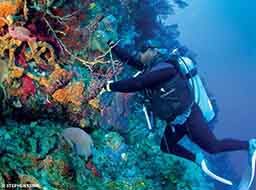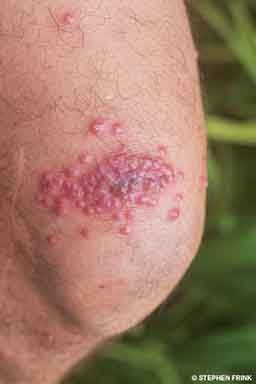Q: Recently I’ve seen many reports of downdraft currents on various online forums accompanied by debates about the best method for escaping them. Do any of DAN’s experts have an opinion or advice?
A: As you will probably appreciate, there is no formal body of research addressing this specific question. The appropriate response and the degree of vigor required will be influenced by the depth, strength and volume of the downdraft, the distance from the eddy line (the edge of the draft), the topography, visibility, risk of entanglement or entrapment, the bulk of the diving equipment worn, the strength, power, buoyancy control, skill, decompression status (or obligation) of the diver and potentially other factors. What seems like a simple question quickly becomes impractical to study in a safe, controlled and still meaningful manner.

Even without quantification of the actual effort required, the question can be addressed conceptually. The priority is maintaining control — particularly vertical control — to avoid serious buoyancy and/or gas-space issues that could make the situation worse. Getting negative, hugging the reef and climbing out rock by rock might be workable if the strength and size of the current flow required it and the topography allowed it. The advantage of this approach is control. The diver is unlikely to have serious shifts in buoyancy or of gas in sensitive spaces (primarily the middle ears and lungs) when control is maintained.
Again, depending on the conditions, swimming perpendicular to the flow could be effective. An advantage of this may be a reasonable degree of control, with minimal need for fast changes in buoyant state or risk to sensitive gas spaces. Choosing to increase buoyancy probably represents the greatest risk of all. While it may be necessary in extreme situations, it is also possible that it could result in an overcorrection and the subsequent hazards of an uncontrolled ascent, the latter resulting in an elevated risk of barotrauma and decompression illness.
My fundamental recommendation is that divers think in advance and be prepared with a continuum of responses from which to choose and, when appropriate, to shift between. The progression of the graded response would be as follows: a mild downdraft could be ignored; a little more strength would prompt horizontal swimming to move out of the affected zone (with minimal or no addition of air to the BCD); even more strength or an uncomfortably large downdraft flow zone would prompt grabbing the wall for stability and, possibly, climbing out. A minor amount of gas might be added to the BCD at the hanging-onto-the-wall point, but not as a primary part of the solution. Adding too much positive buoyancy could create a situation more dangerous than the initial hazard. It could pull the diver off the wall, precipitate a runaway ascent or make what could otherwise be a mild case of entanglement extremely problematic.
Mental practice is an important way to improve skills and responsiveness. A critical part of this effort is to remember that every event has its own idiosyncrasies. Having multiple options and the physical skills and calm demeanor to employ them in a thoughtful, progressive manner will provide the best protection.
—Neal W. Pollock, Ph.D.
Q: On a recent outing with my dive club, we spent some time kneeling in the sand while practicing skills. My knee is now irritated and covered in red bumps. What happened?

A: This particular pattern of red bumps is most likely the result of hydroid stings. These organisms, which can look like plants, seaweed or clumps of feathers, are actually invertebrates of phylum Cnidaria. Like their relatives, fire corals and jellyfish, these animals have tiny stinging cells known as nematocysts. Hydroids are carnivores and use their nematocysts to catch passing plankton and shrimp. The stinging nematocysts may also fire into the skin of unsuspecting divers, which results in a cluster of red welts and bumps that burn and itch.
To treat these injuries, rinse the skin immediately with seawater. Try to refrain from rubbing the area, as this may induce further nematocyst discharge (this is easier said than done). Never use fresh water as it may actually cause undischarged nematocysts present on the skin to fire. Once the area is well irrigated with salt water or saline, apply white household vinegar (4 to 6 percent acetic acid) to help neutralize remaining nematocysts. If vinegar is not available, isopropyl (rubbing) alcohol may be used. Pain can be treated with the local application of heat or hot water.
Once neutralized and cleaned, topical steroids such as hydrocortisone and antihistamines such as Benadryl (diphenhydramine) are commonly employed to reduce local skin irritation and itching. If the reaction is severe or persistent or an allergic reaction occurs, seek medication attention immediately. Reduce your risk of contacting these organisms with good buoyancy control and exposure protection such as wetsuits or dive skins.
—Lana Sorrell, EMT, DMT, and Nicholas Bird, M.D., MMM
Q: At the end of a recent dive, my inflator became stuck as I was adding air to my BCD. I made an uncontrolled ascent from 50 feet to the surface. My computer shows that I had a total bottom time of seven minutes. This was about five hours ago. I don’t think I held my breath at any time, and I feel fine now, but should I be worried?

A: An uncontrolled ascent does not necessarily mean an injury. Your dive profile is not associated with a significant inert gas load, which means you have little reason to be concerned about decompression sickness. The greater concern with uncontrolled ascents is the possibility of pulmonary barotrauma (lung overexpansion injury), which may result in arterial gas embolism (AGE). Pulmonary barotrauma is most often associated with a diver holding his breath while ascending, with the greatest risk existing in shallow water. The signs and symptoms of AGE occur at or near the surface either during ascent or within minutes of surfacing. They do not occur hours later.
People who experience an uncontrolled ascent should stay out of the water for several hours to ensure that symptoms do not occur. While we are unaware of an absolute safe cutoff, the surface time you described (five hours) without symptom onset is very reassuring, and in such cases further medical evaluation is probably unnecessary. If any neurological or respiratory symptoms develop, seek immediate medical attention at a local emergency facility.
—Marty McCafferty, EMT-P, DMT
Q: I typically dive using enriched air nitrox (EAN) with a mix that varies according to planned depths. I also dive with a small pony bottle as a redundant source of breathing gas for emergencies. My buddy suggested that having compressed air in the pony bottle instead of EAN could potentially place me at risk for decompression sickness. Is that something I need to worry about?
A: The theoretical risk of having air in the pony bottle is that the higher fraction of nitrogen would increase inert-gas uptake and ultimately increase the decompression stress. However, since ascent to the surface should immediately follow a switch to the pony bottle, the time spent breathing this gas would be short. In addition, both the partial pressure of the gas being breathed and the importance of the difference between the gases progressively fall as depth decreases. While the ideal choice would be to have EAN in both systems, the practical increase in risk by having air in the bailout system is a very small factor far outweighed by the potential benefits of having a readily available bailout supply.
— Neal W. Pollock, Ph.D.
Q: I read on the Internet that coral can continue to grow under my skin. Is that true?
A: No. Coral cannot live in human bodies. Corals are marine animals and are unable to grow outside of the marine environment. Some bacteria, parasites and other foreign organisms evolved to live and replicate within human tissues, but corals did not.
Although both humans and corals are members of kingdom Animalia, their tissues and body systems are incompatible. Histocompatibility is the property of having the same alleles for a set of genes called the major histocompatibility complex (MHC). The genes of the MHC exist in the tissues of most organisms and act as antigens in the presence of incompatible organisms. Antigens prompt the creation of antibodies by the immune system of incompatible organisms. In humans, the MHC is called the human leukocyte antigen (HLA) system. Since coral does not have an HLA, the human immune system treats it as a foreign substance and attacks it.
When you are injured, your body activates, recruits and increases production of leukocytes (white blood cells). This leukocyte production contributes to the pus that can accumulate at wound sites and promotes the elimination of foreign material. If the body is unable to eliminate foreign material (such as coral), it will wall off the substance with immune cells, forming a granuloma. If this occurs, you may be able to feel a lump under the skin where the granuloma formed.
Keep an eye out for infection (manifesting as redness, swelling, warmth and pain) with such injuries, but rest assured that coral isn’t growing under your skin.
— Niles Clarke, EMT, DMT
© Alert Diver — Q2 Spring 2013